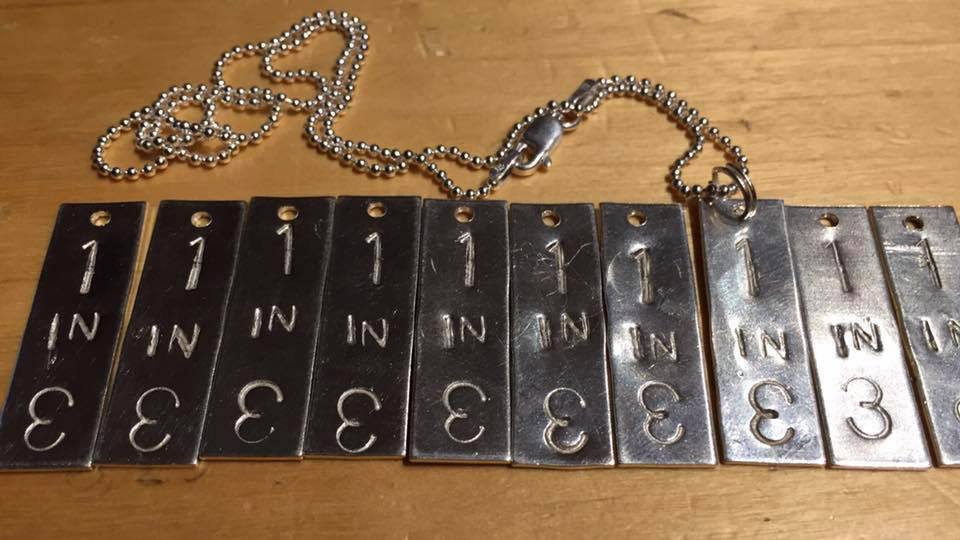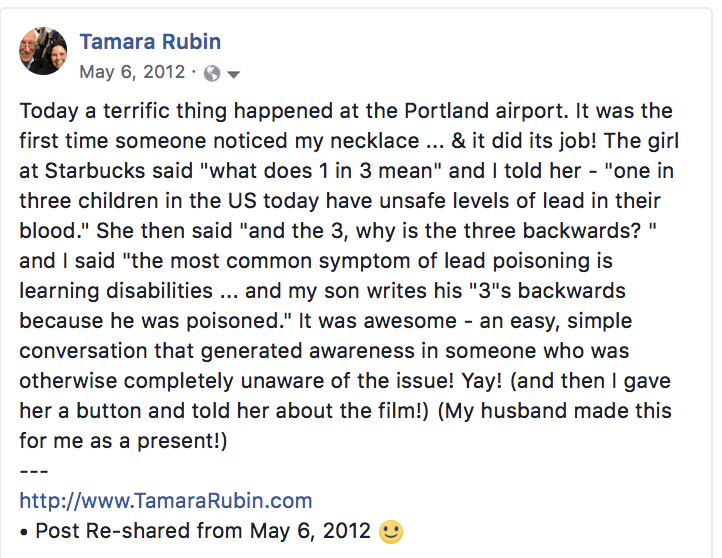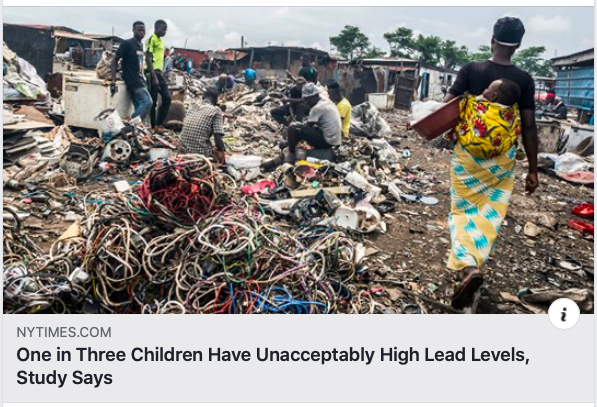A New York Times Article Published Today, July 29, 2020 (reconfirming the main concept guiding my advocacy work for the past 12+ years)
For those new to this website:
Tamara Rubin is a multiple-federal-award-winning independent advocate for childhood Lead poisoning prevention and consumer goods safety, and a documentary filmmaker. She is also a mother of Lead-poisoned children (two of her sons were acutely Lead-poisoned in 2005). Since 2009, Tamara has been using XRF technology (a scientific method used by the U.S. Consumer Product Safety Commission) to test consumer goods for toxicants (specifically heavy metals — including Lead, Cadmium, Mercury, Antimony, and Arsenic). Tamara’s work was featured in Consumer Reports Magazine in February 2023 (March 2023 print edition).
1 in 3 children are Lead poisoned.
First, I would like you to read a Facebook post I wrote awhile back —
a little over EIGHT YEARS AGO:
1 in 3 kids…
While the Facebook post in the image above is from 2012, it was actually back in 2008 that I started sharing the fact that my analysis of the CDC’s raw data clearly demonstrated how “1 in 3 kids” (= 22 million kids) in this country has had an unsafe level of Lead in their blood in their lifetime (based on my review of the research and the CDC’s own internal “unpolished” statistics at that time — and starkly contradicting the popular narrative pushed to the media by the CDC, EPA, etc.)
Today the EPA/CDC narrative continues to repeat a tidy little (custom-derived/ heavily-contorted) “official” statistic that “only” five hundred and thirty-five thousand American kids are currently poisoned. The FIRST time I shared my “unique perspective*” (that it is actually 1 in 3 kids and that the CDC numbers were intentionally manipulated to be falsely low) with the advocacy community was at the 2008 National Healthy Homes Conference in Baltimore, Maryland (where I was an invited guest of the CDC). At that time the CDC’s official estimate was that “only 310,000” American kids were poisoned.
*i.e. an un-massaged, un-politicized, logical/ rigorous interpretation of their own verified internal raw data — only “unique” at the time in that these public agencies refused to privately confront, much less publicly acknowledge, the truth about the full scope of childhood Lead-poisoning (that their own data sets inescapably spelled out to any honest, clear-headed, mathematically-literate person who cared or dared to connect the dots).
I mention the “1 in 3” statistic in the trailer to my film:
Continue reading below the image:
The New York Times
Now — today, on July 29, 2020 — nearly twelve years exactly after dropping my “controversial bombshell” on the conference attendees from the CDC (and other Childhood Lead-poisoning Prevention professionals in attendance at that conference), a bombshell that, based on my analysis of the CDC’s own internal data, the scope of this public health crisis was significantly understated — conservatively, by close to TWO ORDERS OF MAGNITUDE**, Rick Gladstone, a journalist for the New York Times writes an article stating this fact as if it is some kind of groundbreaking new discovery (by Unicef and partners in the collaborative study he references in his article).
This is not NEW.
This is not GROUNDBREAKING.
Before today these numbers were NOT unknown. There are hundreds of researchers, scientists, medical professionals, policy makers, nonprofit administrators and others who work daily in this arena (childhood Lead poisoning prevention) and who have known this information (and have been speaking this truth / sharing this with the public) for decades (since long-before my children were poisoned) — yet no one seems to be listening. My voice (and my story) is just one among hundreds (if not thousands). The ears of the public (and the media) seem to be (consistently) deaf to the truths about the extent of Lead poisoning. Just because Unicef and the New York Times declare this as “new” information does not make it so. The information has been there all along, behind a veil of political coverups, including politically massaged statistics available for anyone to see, anyone willing to take a deeper look at the actual numbers (what they mean, where they come from and how the public statements have been derived from manipulations of the raw data). This is covered in my documentary film.
A 12+ year delay…
Popular understanding/ societal consensus and “currently acknowledged science” consistently lags behind truth being revealed by independent researchers, scientists and advocates reviewing the raw data and digging deep. This lag in the information pipeline eventually translates to journalists reporting “new” facts — at least 5 to 12 years after they are discovered/uncovered/learned, publicly stated and widely available. If you have seen my film you know this.
Five to 12 years in my personal experience (just one example)…
I say “five to 12 years” because (in my personal experience) other follow-up studies (or other “ground-breaking” & “new” information) about facts I have personally discovered — or uncovered — about Lead have appeared as feature stories on the wire services, generally, in most cases at least 5 years after I first started writing about that fact on my website and social media. This has included stories about the prevalence of Lead in currently-manufactured cups, mugs and dishware, the potential concern for Leaded decorations on new and vintage dishware; the prevalence of Lead in mouthpieces for both student and professional trumpets, and the presence of Lead (and Cadmium) in vintage plastic toys. The only bit of research that I did that had a shorter delay between my research/ reports and someone else reporting it as “new” and “groundbreaking” data (when it was co-opted by an “official” nonprofit organization, who published a press release stating it was their own research) was when I discovered unsafe levels of Lead in the then wildly popular new fidget spinners in 2017. During this incident, USPIRG announced their “discovery” (of Lead in the very same models of fidget spinners I had tested) just about five months after my articles on the subject went viral.
How do I feel about this?
While my personal feelings on this are really irrelevant, first and foremost I am all for team work, collaboration and momentum in advocacy. Any news coverage about the issue is good news coverage, however I am still sorting out how this New York Times article (and specifically the headline and the import of the headline) have made me feel. It’s a really mixed bag. I am (on the one hand) genuinely thrilled that a New York Times piece published something truly “earth-shattering” — even if it something that the Lead poisoning prevention advocacy community has long known to be fact. I am also a little skeptical about the quality of the journalism on the piece (and digging even deeper — skeptical about the quality of the statements and conclusions made by Unicef in the source report) given this “unknown” fact monopolizing today’s headlines is something I (and others) have written about and spoken about frequently over the past decade and even something I included in my film (from the very first rough-cut edit back in early 2012). In the film the true number of children (“more than 1 in 3”) impacted by Lead poisoning is a fact mentioned in the 2012 interview with Dr. Bruce Lanphear — one of the top research scientists on the issue.
I am also SICK to my stomach.
“Out of the mouths of ‘old white men’…”
I am SICK knowing that the voice of a female parent-advocate (a Mother of Lead-poisoned kids — an advocate with both deep and professional knowledge and expertise — and also intimate personal experience) practically screaming these same words from the rooftops for the past 12 years (diplomatically, politely, metaphorically “screaming” and creatively “screaming” via my work with the website, public speaking, and filmmaking) did not get the “huge story” (that 1 in 3 kids are poisoned!) into “the paper of record” (The New York Times) in this way.
I feel sick that it took an article written by a man, with quotes from men (and from several organizations run by men — including Pure Earth, IMHE, and O.K. International) for these statistics to be seen as real. (Why was the voice of a woman stating this same truth for more than a decade — confirmed by top scientists, statisticians and medical experts interviewed in my film — apparently not deemed sufficiently credible or newsworthy? Why is it being considered “new” and “groundbreaking” now, now that it is validated by men within the establishment?)
SICK that millions of children have continued to be poisoned for these past 12 years (in spite of my doing everything I could imagine to share this “revelation”) and — most profoundly depressing of all — will continue to be poisoned, in spite of this being covered in this way in the New York Times.
I’m sick at how misguided the Times article ultimately is.
I am also sick that the Times article is ultimately misguided, and does everything to support the tired Lead industry-crafted false narrative that childhood Lead poisoning is predominantly linked to poverty — and not that it is an “everyone” problem (a planetary problem). I think that is the part (of this New York Times article, the Unicef research report and nearly ever article ever written since my kids were poisoned back in 2005) that is most personally upsetting — that this opportunity to write an unbiased article with a universal warning that could have finally shifted public opinion with long-term implications for meaningful policy change was ultimately squandered by the continued misrepresentation of the issue through regurgitating the carefully-crafted (Lead-industry created narrative) language about how the impact is “primarily” or “only” on “the poor.” Until Lead-poisoning is seen for what it actually is — an “everyone” problem — the necessary large-scale action (and allocation of funding) to create real change simply will not happen.
The journalist probably doesn’t even understand that the narrative he created for this article is biased — and rooted in a false narrative crafted by the industry that created this problem. (I wrote more about that here.) He probably has no idea that prominent scholars and historians revealed that this narrative was created and propagated by industry (rather than an actual epidemiological truth) as far back as 1968-1971 (see here).
I’m sick at the lost opportunity for the cause.
So if I had to summarize how I feel about the article, I would have to say I am happy for the any potential collateral wake-up from this “echoic blip,” but predominately sad, disgusted, and frustrated. The lost opportunity and the cliche reinforcement of the deflective false narrative will likely predictably result in this potentially disruptive article (and the Unicef research report on which it was based) ultimately being just one more article seen as short-lived infotainment — likely with nothing done in response. At the end of the day, the tragedy is that it is not a call to action and the journalist’s (ignorant and already virtually anachronistic) view that acknowledges an ostensible “need” for Lead in automobile batteries is almost a call to complacent resignation about the poisoning of (at least) 1/3 of the planet’s human population.
I’ll be writing more about this (the news coverage of the Unicef report and the report itself) in the coming days, so stay tuned. I’m not done thinking about it and responding!
Some additional links:
- My website: http://www.LeadSafeMama.com
- The trailer to my film (which mentions the “1 in 3” number): https://youtu.be/AdOoqiafr1s
- Here’s the film if you haven’t seen it: https://youtu.be/eRKlaC2EjL0
- My article clearly outlining how I came up with the “1 in 3” number mentioned in my film: https://tamararubin.com/links/
- Here’s the link to the Unicef report (I have also uploaded the PDF of the original report here.)
- Here’s the New York Times piece from today: https://www.nytimes.com/2020/07/29/world/americas/lead-poisoning-children.html
- These are the necklaces my husband and son designed years ago — for mothers of Lead-poisoned children to wear (and this piece has more links and information about how I came up with the “1 in 3” number): https://tamararubin.com/2017/05/necklace/
As always, thank you for reading and for sharing this work. Please let me know if you have any questions (ever)! I will do my best to answer them personally.
Tamara Rubin
#LeadSafeMama

Never Miss an Important Article Again!
Join our Email List











Tamara, I am wondering your thoughts on the effects of the widespread lead poisoning that occurred in the ~30s-40s to 80s as a result of leaded gas. Clearly our parents and grandparents were affected by this, as average American blood lead levels for adults and children alike were 15-25 micrograms per deciliter, far higher than any acceptable standard today. There is data to suggest that this widespread lead poisoning was strongly linked to higher crime rates, though with no causative evidence. Why aren’t developmental or learning disabilities almost uniform among this older population? When discussing lead poisoning today among children, it is so odd and almost contradictory to me that we say “levels under 5mcg per dL cause permanent brain damage”, and yet children were routinely exposed to lead levels far higher than that for decades and we don’t refer to those now-adults as brain damaged.
Hi there, These questions are thoroughly answered in my documentary film, which is 92 minutes long.
Here’s the link on Youtube: https://youtu.be/eRKlaC2EjL0
You may also find this post helpful:
https://tamararubin.com/2015/02/fine/
and here’s another article you might find helpful:
https://tamararubin.com/2017/01/toxic_lead/
and one final one:
https://tamararubin.com/2017/01/what-is-the-impact-of-lead-poisoning-in-adults-including-college-age-students/
If you still have questions after watching the film and reading these articles, please let me know.
Tamara
You go, Tamara!
Someday you will be rewarded and validated on a large scale for your work.